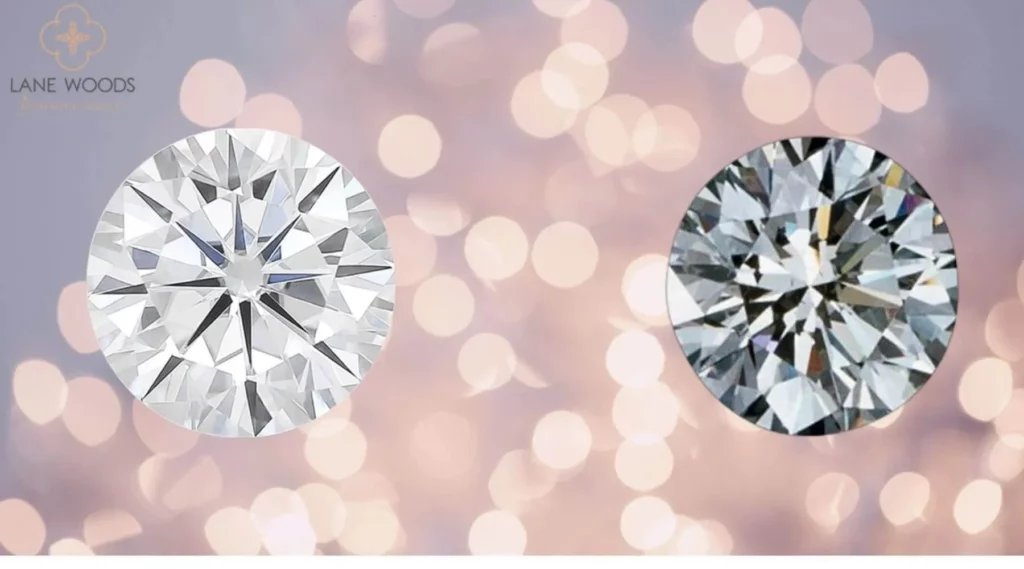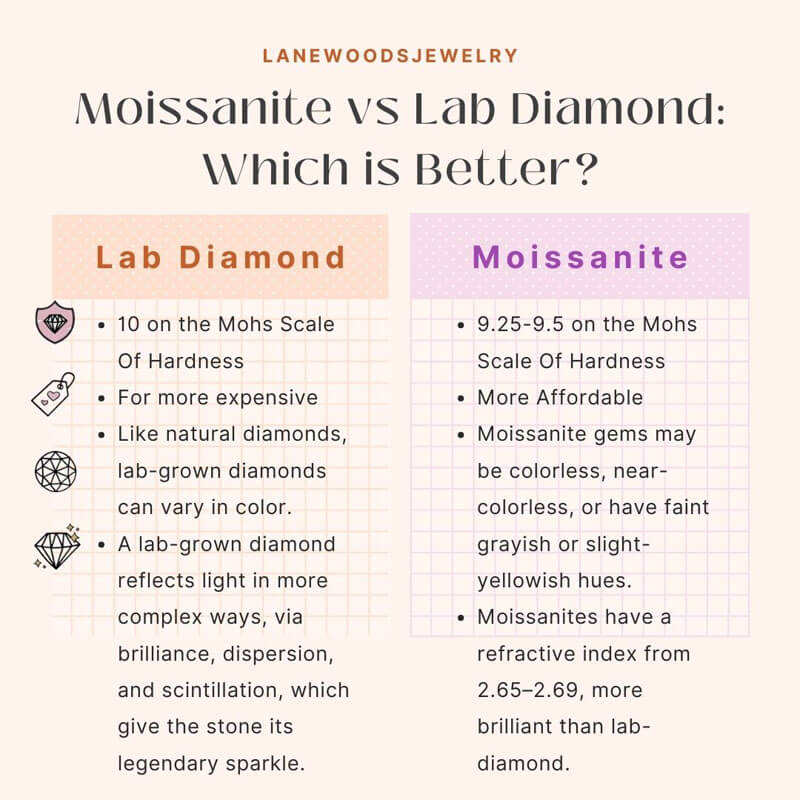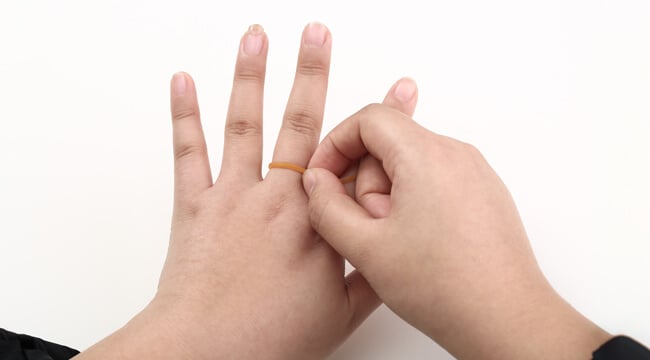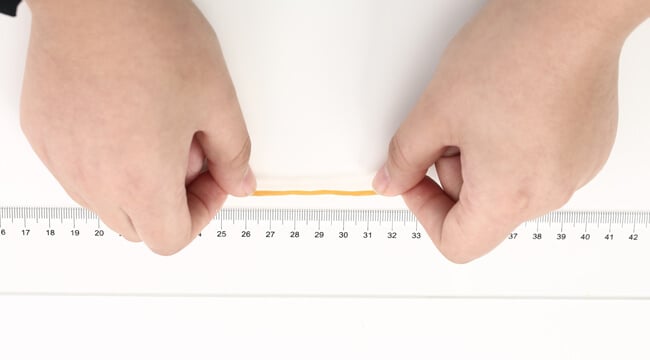Diamonds may last forever, but not everyone can afford the high price tag of owning one. That’s where moissanite and lab diamonds provide affordable alternatives to natural diamonds – both being man-made gemstones that resemble their look and feel but differ significantly in composition, durability, and price.
In this article, we’ll compare moissanite vs. lab diamond and help you decide which gemstone would best meet your needs.
Main Differences Between Moissanite and Lab Diamonds
While both moissanite and lab-grown diamonds are attractive and durable, they differ significantly in appearance, price, and durability. Moissanite, crafted from silicon carbide, has a distinct glow, whereas lab diamonds, made from carbon, share physical and chemical characteristics with natural diamonds.
What is Moissanite?
Moissanite is a naturally-occurring mineral first discovered by French scientist Henri Moissan in 1893. Resembling diamond in appearance, Moissanite can often serve as an alternative choice in engagement rings.
Moissanite’s Key Attributes
Moissanite features several characteristics which distinguish it as unique:
- Brilliance: Moissanite is known for its stunning brilliance, often being compared with diamonds for this quality.
- Hardness: Moissanite is the second hardest gemstone after diamond.
- Color: Moissanite gemstones typically exhibit a near-colorless hue with faint yellow or green tones.
- Price: Moissanite is more cost-effective than diamonds when it comes to gemstone purchases.
What is a “Lab Diamond”?
A lab diamond is an artificial diamond created in a laboratory setting that shares similar physical and chemical characteristics as natural diamonds but is produced under controlled circumstances.
Lab Diamond Characteristics
Lab diamonds exhibit several defining features:
- Brilliance: Lab diamonds match natural diamonds when it comes to brilliance.
- Hardness: Lab diamonds possess the same hardness as natural diamonds.
- Color: Lab diamonds come in all colors imaginable – from colorless and near-colorless to subtle yellow or brown tints.
- Price: Laboratory diamonds tend to be cheaper than their natural diamond counterparts but more costly than Moissanite.
Moissanite Vs Lab Diamond: What Are the differences?
Moissanite and Lab Diamonds have similar visual characteristics to diamonds, but there are some differences. Here are some factors to consider when choosing between Moissanite and Lab Diamond.
Composition
Moissanite was first discovered by French scientist Henri Moissan in 1893. Jewelry-grade moissanite today is produced in laboratories by replicating its chemical composition and crystal structure; making use of silicon carbide, it boasts a hardness of 9.25 on the Mohs scale.
Lab diamonds, on the other hand, are man-made yet consist of pure carbon like natural diamonds. Created using cutting-edge technology in a laboratory that simulates conditions found within Earth’s mantle where diamonds form naturally, lab diamonds possess all of their chemical and physical properties such as hardness on the Mohs scale ten rating as natural ones do.
-
Sparkle
One of the biggest distinctions in Moissanite is its sparkling. The term sparkle is used by experts to describe dispersion. Moissanite has a dispersion rate of 0.104. However, a diamond has a dispersion rate of 0.044.
So, we can say that Moissanite sparkles more brightly than diamonds and is more vibrant than diamonds. If you examine the Moissanite juxtaposed with a diamond, it’ll be clear which one is the Moissanite since it’s the one that sparkles like disco balls!
Lab diamonds are designed to reflect light in the same manner as natural diamonds do. When it comes to the sparkle of moissanite vs lab diamond rings, there is a distinction, yet there isn’t a right or incorrect. It’s all in the personal your personal preference.
-
Color
Color is another attribute that can be used to distinguish the two. While lab diamonds and moissanite appear very similar in appearance, however, there are some differences.
Lab diamonds are readily available in mostly all colors. They may be “colorless,” “near-colorless,” or any of the rainbow colors such as red, blue, or purple.
In contrast, natural moissanite comes in three shades. Consists of Colorless, virtually colorless, and yellowish-green shades.
It is important to note that colored Moissanite was made by coating it with green and blue. However, with the advancement of technology, scientists will create colored moissanite.
-
Durability
One method that jewelers evaluate the strength of a gem is through their Mohs scale for hardness. The Mohs hardness scale determines the level of scratch resistance your gemstone has. A hardness score that is high indicates whether your stone can hold up against the hustle and bustle of daily life.
Diamonds are the hardest. They have the highest score on the scale of hardness which is a 10. Diamond is the hardest substance on Earth. A lab diamond isn’t different in hardness, either. Moissanite has the closest solidity to a diamond, sitting at 9.25.
In terms of the longevity of moissanite engagement rings and diamond engagement rings, there is only a small distinction. The same is true when it comes to a moissanite engagement ring versus a lab diamond. They are both extremely sturdy, and practically impervious to scratches and be used for everyday usage.
Remember that just because a stone is hard does not mean that a powerful hit to either stone will not break or chip it. The pressure applied to the moissanite or lab diamond could increase the chance of scratches appearing on the surface of the stone. In this instance, it’s better to be safe instead of regretting it!
-
Price
Price is often a decisive aspect when deciding between a moissanite engagement ring vs diamond engagement rings as well as a moissanite or lab diamond.
Moissanite or lab-created diamonds offer affordable alternatives to a diamond ring. But, Moissanite is cheaper compared to diamonds made by labs. This is among the main reasons that it’s the most sought-after diamond substitute.
It is a perfect replacement for diamonds if you’re short of funds.
You May Want To Know Moissanite Vs Cubic Zirconia.
Pros and Cons of Moissanite and Lab Diamond
Moissanite Pros
- Moissanite is significantly less expensive than lab diamonds and natural diamonds, making it an affordable option for those on a budget.
- Moissanite has a higher refractive index than diamonds, which means it sparkles more and has more fire.
- Moissanite is a conflict-free and eco-friendly alternative to natural diamonds since it is created in a laboratory.
Moissanite Cons
- Due to having different crystal structures from diamonds, Moissanite may appear different under certain lighting conditions.
- Moissanite is not as hard and scratch-resistant as diamond, making it more vulnerable over time to scratches or chips.
- Moissanite is not as rare or valuable as diamonds, which may be a concern for some consumers.
Lab Diamond Pros
- Lab diamonds share many of the same physical characteristics as natural diamonds, including brilliance, fire, and scintillation.
- Lab diamonds are less expensive than natural diamonds, making them a more affordable option for those who want a diamond look without the high price tag.
- Lab diamonds are conflict-free and environmentally friendly since they’re produced in a laboratory.
Lab Diamond Cons
- Lab diamonds are still more expensive than moissanite, which may be a concern for those on a tight budget.
- Lab diamonds may not be as rare or valuable as natural diamonds, which may be of concern to some consumers.
- Lab diamonds do not come with as unique an appearance compared to natural diamonds – this may pose problems for those wanting a one-of-a-kind piece of jewelry.
Which one is Better?
The “better” choice hinges heavily on individual preferences and budget. If a sparkling, budget-friendly, and eco-friendly option entices you, moissanite is the way to go. Conversely, if you prefer something closely aligned with natural diamonds without the hefty price tag, lab diamonds could be your pick.
Research diligently, ponder over factors like cost, durability, and visual appeal, and consult with a professional jeweler to find your perfect match.
Where Can I Shop a Moissanite Engagement Ring?
Right here! Lane Woods Jewelry provides conflict-free, moral moissanite rings. We provide a number of various moissanite ring styles, including round cut, princess cut, cushion cut, oval cut, and these options with solitaire, halo or 3 stone also.
We likewise support 30-day returns, cost-free shipping. Start here to choose a moissanite ring!










